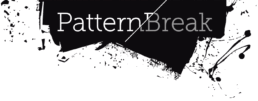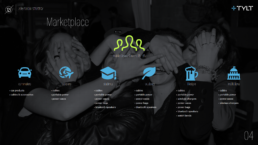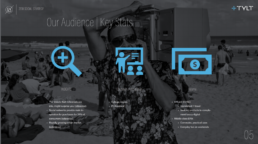Let it Happen: Organic Disruption
We often think of Disruption solely in terms of innovative technology. Some new thing that comes along and reels us in with its new found convenience. We hear about it, we try it, and at some point it becomes part of the fabric of our lives. The technology or service works its way into our culture, and maybe even becomes its own verb one day. The parade of the world moves on.
The products or services that got disrupted are put on life support and sent off to a home for the aged. We don't hear about them much, only in terms of their inevitable demise. For the most part we look away, and maybe take a silent sadistic pleasure in seeing the once mighty, fall to Earth. There will be notable moments when a once unshakeable brand is in its last death throes and does something exciting like hiring a hotshot ad agency, but for the most part they wither away, dying a long, slow death. We struggle to explain their cultural significance to our children, who at best consider them quaint.
There are plenty of modern day technology evangelists who hold Ted Talks about how the end is near and that smart brands must to repent and go to the mountain top, to be born yet again. They probably have a graph that references Moore's Law so that we can see the unraveling of the status quo in near real time. Some have real concrete answers but most are peddlers of fear. Making a living out of pointing out the obvious. CMOs buy their books in secret and clandestinely try to apply the algorithms of change to their businesses. There is no fault in any of this, some companies need a forceful disruption to reset. A slapping of the face and a shaking of the shoulders. An awakening.
Creative businesses are easy to evolve because the core service offering, Creativity is needed in just about everything and everywhere in our lives. Do creative businesses need Disruption? Hell yes, more than just about anyone. Oftentimes creative agencies are the ones called upon to do the actual disrupting. "Dodge wants to change its image and appeal to a more urban audience", or "Snickers wants to be relevant again", are all cries for help - begging to be Disrupted and reconstituted into a new cooler form, with only hints of its nostalgic legacy poking through a new, shiny plastic facelift.
But what if the Disruptors need to be Disrupted themselves? Who does the disrupting? It must come from within.
The reality of being a creative business (a business that sells creative) is that if they are successful, they naturally don't have time and resources to do free creative work on their own brand. Perhaps every few years they'll contrive a push to rebrand, but these attempts feel forced and as the agency grows, the quality of their own brand often diminishes. Agencies make soft attempts at having cool social media channels, but they know that ultimately they'll be judged by the work they've done for their clients and not for the work they've done for themselves. In fact, there is even a silent expectation that the agency's own marketing can't be that good, because they're too busy doing awesome work for other people. Oh, the sacrifices they make for others. The Cobbler's children sadly have no shoes of their own.
We believe this agency paradox is so unchangeable, it might as well be a natural law of physics. If you are a creative business relating to any of this, know that it's not your fault and you're not alone. In fact, PatternBreak was created just for you. We are former agency owners that experienced all of the ups and downs of running a small ag
By definition, any successful Disruption has victim. Its name is " The Old Way of Doing Things". A casualty of innovation and evolution. Some people, companies and brands accept this fate when their number is called, and wander off into the pasture of retirement or obsolescence.
Just because your middle aged, doesn't mean you have to live in the middle-ages.
But there are others, like Bowie or Gucci, who were able to constantly reinvent themselves in a meaningful way. These celebrities and brands were able to disrupt your notion of who they were, while leveraging the nostalgia of the their legacy.
Consumers don't often have that Eureka moment about a brand until they've had a few exposures to it. They may not remember hearing Ed Sheeran at a coffee shop or nightclub, but maybe it's the Grammy's that seals the deal.
Organic disruption is good, and there is really not much we can do about it anyway, since it emerges from a natural process. For instance, Uber can be considered a natural disruption to the transportation industry. Uber's purpose was to solve a problem. The solve for that problem had the side effect of disrupting transportation. If Uber's founders had not disrupted the taxi business, and still become billionaires, they would have been just as happy. The argument is that disruption for the sake of disruption was not the sole objective. So, it is an organic disruption. In their hubris, they may suggest that the point was to indeed disrupt from the onset, but from a business perspective, the first and foremost objective was to build a successful business, and if it happens to disrupt, so be it.
As with any overused term, the original meaning of disruption has been over simplified, bastardized and co-opted. There is an idea that by simply shaking things up, hitting them with a hammer, destroying the structure of things and deconstructing something that the net result will always
Social Media Strategy, Defined
A social strategy provides a game plan for your brand’s marketing efforts across all social media networks. It should answer the simple question, “What can we realistically expect to achieve on social media within the next X months?” In order to answer this question, the most important thing for a client to consider is their paid media budget. The performance of any branded social channel is reliant upon how much money is spent on promoting it through social ads, managed through the various control panels on each platform. No matter how creative your posts are, you will not move the needle without paid media. Great content is necessary to initiate phase 2, user engagement, but they’ll never see your creative in the first place without paid media. Knowing your budget tolerance for paid media is step one in determining what might be possible to achieve within your given timeframe. Ideally, you would know this number before creating your RFP for agencies and consultants. I would ask them, “how would you direct the spending of this budget?”. No one can tell you the exact results, but an experienced Strategist will be able to share case studies of clients who’ve increased their budgets, and what kind of results those clients saw.
A not so uncommon question we hear from new clients is, “How much should we expect to spend?” The answer is necessarily blunt, “…as much as you can afford.” If I were a marketing director or CMO, I would dedicate half or more of my social media budget to paid advertising. For the sake of argument, let’s just say that your company is new to this and you need to make an argument to your superiors for a reasonable budget. In that case, you can still build the bones of your strategy, the plan, without a solid number, it just can’t be initiated in any realistic way without a paid media budget.
A parent brand may have multiple channels on a single network. For instance, there might be a brand channel “Company X” and a separate channel for an individual product, “Company X’s Product A” and still another, “Customer Support for Product A”. The overarching brand strategy, at the “Company X” level will need to take into account the basic rules of decorum, graphics standards, messaging style, etc., while leaving each brand variant plenty of room to develop its own identity. The strategy is typically driven by sales goals such as “increasing sales by x%”, but may also take the form simply gaining awareness or influencing public opinion. Some brands don’t know what their goals are, only that they “need more followers”. In that instance, it is up to the consultant to recognize that, while yes, increased followers are an easy metric for anyone to understand, clients should begin to view engagement as the most important stat to watch (on social, clicks on ads). At the end of the day, that is what every brand wants – more. Brands At the end of the process the strategy manifests itself in the form of a document.

Remember to
never give up
If no one hates you, no one is paying attention. If attention is what you want for vanity, confidence, or, hell — to make a decent living — then know that it’s not instantaneous. Every single person that you’re currently paying attention to, at some point in their lives, was in your exact position. They kept at it and worked enough so that others started listening. Also know that if no one is watching, you can experience true freedom. Dance in your underwear. Write entirely for yourself. Swear like there’s a going-out-of-business sale on “fucks” and “shits.” Find yourself — not in some coming-of-age hippie way involving pasta and ashrams— but in a way that helps you draw your own line in the sand for what matters and what doesn’t. Do what you want to do, just because you want to do that thing. This will build confidence that will come in handy later.







